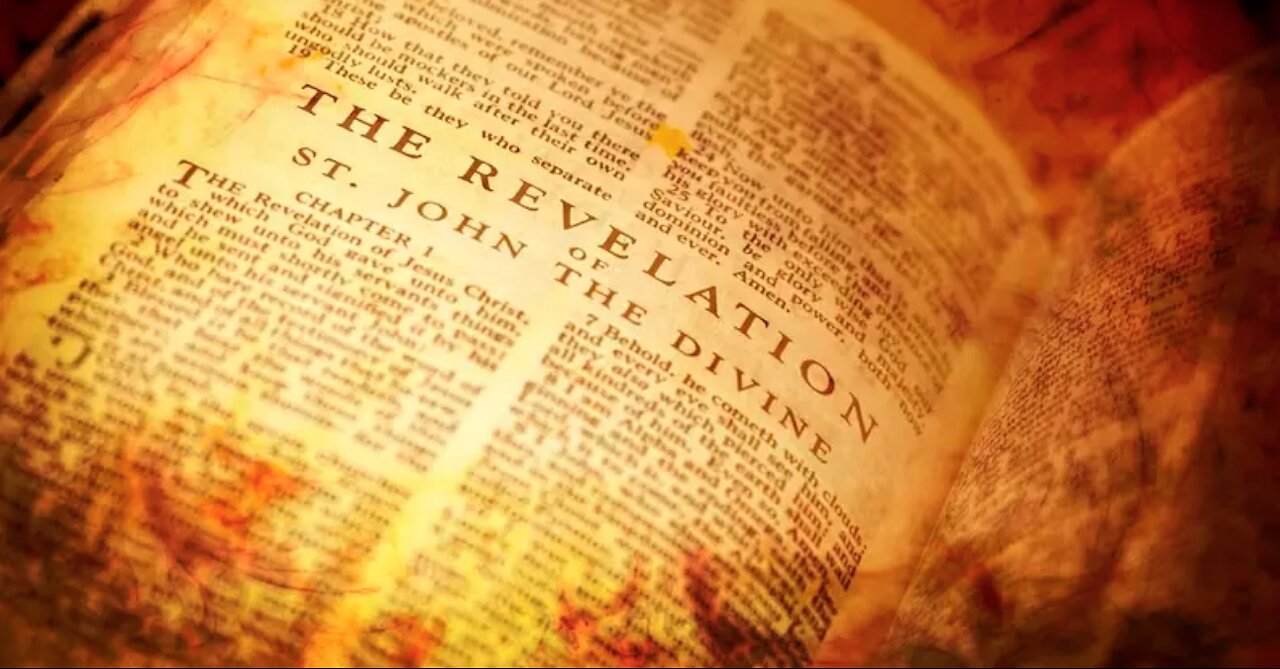Premium Only Content

THE BOOK OF REVELATION
Book of Revelation | Read by Alexander Scourby | AUDIO & TEXT
** https://www.youtube.com/@ScourbyYouBible
BIBLE INTRODUCTIONS – REVELATION
Unlike most books of the Bible, Revelation contains its own title: “The Revelation of Jesus Christ” (1:1). “Revelation” (Gr., apokalupsis) means “an uncovering,” “an unveiling,” or “a disclosure.” In the NT, this word describes the unveiling of spiritual truth (Rom. 16:25; Gal. 1:12; Eph. 1:17; 3:3), the revealing of the sons of God (Rom. 8:19), Christ’s incarnation (Luke 2:32), and His glorious appearing at His second coming (2 Thess. 1:7; 1 Pet. 1:7). In all its uses, “revelation” refers to something or someone, once hidden, becoming visible. What this book reveals or unveils is Jesus Christ in glory. Truths about Him and His final victory, that the rest of Scripture merely allude to, become clearly visible through revelation about Jesus Christ (see Historical and Theological Themes). This revelation was given to Him by God the Father, and it was communicated to the Apostle John by an angel (1:1).
Author and Date
Four times the author identifies himself as John (1:1, 4, 9; 22:8). Early tradition unanimously identified him as John the apostle, author of the fourth gospel and three epistles. For example, important second century witnesses to the Apostle John’s authorship include Justin Martyr, Irenaeus, Clement of Alexandria, and Tertullian. Many of the book’s original readers were still alive during the lifetimes of Justin Martyr and Irenaeus—both of whom held to apostolic authorship.
There are differences in style between Revelation and John’s other writings, but they are insignificant and do not preclude one man from writing both. In fact, there are some striking parallels between Revelation and John’s other works. Only John’s gospel and Revelation refer to Jesus Christ as the Word (19:13; John 1:1). Revelation (1:7) and John’s gospel (19:37) translate Zech. 12:10 differently from the Septuagint, but in agreement with each other. Only Revelation and the Gospel of John describe Jesus as the Lamb (5:6, 8; John 1:29); both describe Jesus as a witness (cf. 1:5; John 5:31, 32).
Revelation was written in the last decade of the first century (ca. A.D. 94–96), near the end of Emperor Domitian’s reign (A.D. 81–96). Although some date it during Nero’s reign (A.D. 54–68), their arguments are unconvincing and conflict with the view of the early church. Writing in the second century, Irenaeus declared that Revelation had been written toward the end of Domitian’s reign. Later writers, such as Clement of Alexandria, Origen, Victorinus (who wrote one of the earliest commentaries on Revelation), Eusebius, and Jerome affirm the Domitian date.
The spiritual decline of the 7 churches (chaps. 2, 3) also argues for the later date. Those churches were strong and spiritually healthy in the mid-60s, when Paul last ministered in Asia Minor. The brief time between Paul’s ministry there and the end of Nero’s reign was too short for such a decline to have occurred. The longer time gap also explains the rise of the heretical sect known as the Nicolaitans (2:6, 15), who are not mentioned in Paul’s letters, not even to one or more of these same churches (Ephesians). Finally, dating Revelation during Nero’s reign does not allow time for John’s ministry in Asia Minor to reach the point at which the authorities would have felt the need to exile him.
Background and Setting
Revelation begins with John, the last surviving apostle and an old man, in exile on the small, barren island of Patmos, located in the Aegean Sea southwest of Ephesus. The Roman authorities had banished him there because of his faithful preaching of the gospel (1:9). While on Patmos, John received a series of visions that laid out the future history of the world.
When he was arrested, John was in Ephesus, ministering to the church there and in the surrounding cities. Seeking to strengthen those congregations, he could no longer minister to them in person and, following the divine command (1:11), John addressed Revelation to them (1:4). The churches had begun to feel the effects of persecution; at least one man—probably a pastor—had already been martyred (2:13), and John himself had been exiled. But the storm of persecution was about to break in full fury upon the 7 churches so dear to the apostle’s heart (2:10). To those churches, Revelation provided a message of hope: God is in sovereign control of all the events of human history, and though evil often seems pervasive and wicked men all powerful, their ultimate doom is certain. Christ will come in glory to judge and rule.
Historical and Theological Themes
Since it is primarily prophetic, Revelation contains little historical material, other than that in chaps. 1–3. The 7 churches to whom the letter was addressed were existing churches in Asia Minor (modern Turkey). Apparently, they were singled out because John had ministered in them.
Revelation is first and foremost a revelation about Jesus Christ (1:1). The book depicts Him as the risen, glorified Son of God ministering among the churches (1:10ff.), as “the faithful witness, the firstborn from the dead, and the ruler over the kings of the earth” (1:5), as “the Alpha and the Omega, the Beginning and the End” (1:8), as the one “who is and who was and who is to come, the Almighty” (1:8), as the First and the Last (1:11), as the Son of Man (1:13), as the one who was dead, but now is alive forevermore (1:18), as the Son of God (2:18), as the one who is holy and true (3:7), as “the Amen, the Faithful and True Witness, the Beginning of the creation of God” (3:14), as the Lion of the tribe of Judah (5:5), as the Lamb in heaven, with authority to open the title deed to the earth (6:1ff.), as the Lamb on the throne (7:17), as the Messiah who will reign forever (11:15), as the Word of God (19:13), as the majestic King of kings and Lord of lords, returning in glorious splendor to conquer His foes (19:11ff.), and as “the Root and the Offspring of David, the Bright and Morning Star” (22:16).
Many other rich theological themes find expression in Revelation. The church is warned about sin and exhorted to holiness. John’s vivid pictures of worship in heaven both exhort and instruct believers. In few other books of the Bible is the ministry of angels so prominent. Revelation’s primary theological contribution is to eschatology, i.e., the doctrine of last things. In it we learn about: the final political setup of the world; the last battle of human history; the career and ultimate defeat of Antichrist; Christ’s 1,000 year earthly kingdom; the glories of heaven and the eternal state; and the final state of the wicked and the righteous. Finally, only Daniel rivals this book in declaring that God providentially rules over the kingdoms of men and will accomplish His sovereign purposes regardless of human or demonic opposition.
Interpretive Challenges
No other NT book poses more serious and difficult interpretive challenges than Revelation. The book’s vivid imagery and striking symbolism have produced 4 main interpretive approaches:
The preterist approach interprets Revelation as a description of first century events in the Roman Empire (see Author and Date). This view conflicts with the book’s own often repeated claim to be prophecy (1:3; 22:7, 10, 18, 19). It is impossible to see all the events in Revelation as already fulfilled. The second coming of Christ, for example, obviously did not take place in the first century.
The historicist approach views Revelation as a panoramic view of church history from apostolic times to the present—seeing in the symbolism such events as the barbarian invasions of Rome, the rise of the Roman Catholic Church (as well as various individual popes), the emergence of Islam, and the French Revolution. This interpretive method robs Revelation of any meaning for those to whom it was written. It also ignores the time limitations the book itself places on the unfolding events (cf. 11:2; 12:6, 14; 13:5). Historicism has produced many different—and often conflicting—interpretations of the actual historical events contained in Revelation.
The idealist approach interprets Revelation as a timeless depiction of the cosmic struggle between the forces of good and evil. In this view, the book contains neither historical allusions nor predictive prophecy. This view also ignores Revelation’s prophetic character and, if carried to its logical conclusion, severs the book from any connection with actual historical events. Revelation then becomes merely a collection of stories designed to teach spiritual truth.
The futurist approach insists that the events of chaps. 6–22 are yet future, and that those chapters literally and symbolically depict actual people and events yet to appear on the world scene. It describes the events surrounding the second coming of Jesus Christ (chaps. 6–19), the Millennium and final judgment (chap. 20), and the eternal state (chaps. 21, 22). Only this view does justice to Revelation’s claim to be prophecy and interprets the book by the same grammatical-historical method as chaps. 1–3 and the rest of Scripture.
Outline
The Things which You Have Seen (1:1–20)
The Prologue (1:1–8)
The Vision of the Glorified Christ (1:9–18)
The Apostle’s Commission to Write (1:19, 20)
The Things which Are (2:1–3:22)
The Letter to the Church at Ephesus (2:1–7)
The Letter to the Church at Smyrna (2:8–11)
The Letter to the Church at Pergamos (2:12–17)
The Letter to the Church at Thyatira (2:18–29)
The Letter to the Church at Sardis (3:1–6)
The Letter to the Church at Philadelphia (3:7–13)
The Letter to the Church at Laodicea (3:14–22)
The Things which Will Take Place after This (4:1–22:21)
Worship in Heaven (4:1–5:14)
The Great Tribulation (6:1–18:24)
The Return of the King (19:1–21)
The Millennium (20:1–10)
The Great White Throne Judgment (20:11–15)
The Eternal State (21:1–22:21)
This Grace to You article originally appeared here.
Copyright 2007, Grace to You. All rights reserved. Used by permission.
John Macarthur 2021 - A Jet Tour Through Revelation
https://www.youtube.com/watch?v=1G7Vdbs2Pi4
-
 1:57:34
1:57:34
Kim Iversen
8 hours agoRFK Jr., Tulsi, Kash Patel SHRED Senate Clowns—Democrats Humiliated!
109K107 -
 3:06:08
3:06:08
Laura Loomer
5 hours agoEP 97: Trump's Nominees Transform America
54.7K16 -
 1:03:00
1:03:00
Man in America
13 hours agoThe Helicopter Crash DOESN'T MAKE SENSE... What REALLY Happened???
42.7K59 -
 55:11
55:11
Flyover Conservatives
1 day agoParents WIN, Teachers Unions PANIC! 3 Huge Education Bombshells This Week! - Corey DeAngelis | FOC Show
49.5K -
 1:40:20
1:40:20
Glenn Greenwald
8 hours agoTulsi's Hearing Exposes Bipartisan Rot of DC Swamp | SYSTEM UPDATE #400
106K193 -
 1:19:48
1:19:48
Simply Bitcoin
13 hours ago $8.03 earnedJerome Powells MASSIVE Bitcoin Backflip! | EP 1172
78.9K5 -
 58:42
58:42
The StoneZONE with Roger Stone
5 hours agoLBJ + CIA + Mob + Texas Oil = JFK Murder | The StoneZONE w/ Roger Stone
59.1K27 -
 58:00
58:00
Donald Trump Jr.
13 hours agoBreaking News on Deadly Plane Crash, Plus Hearing on the Hill, Live with Rep Cory Mills & Sen Marsha Blackburn | TRIGGERED Ep.212
190K139 -
 52:03
52:03
Kimberly Guilfoyle
11 hours agoLatest Updates on Deadly Air Collision, Plus Major Hearings on Capitol Hill,Live with Marc Beckman & Steve Friend | Ep.192
108K34 -
 1:17:16
1:17:16
Josh Pate's College Football Show
9 hours ago $2.41 earnedMichigan vs NCAA | ESPN’s ACC Deal | Season Grades: UGA & Miami | Notre Dame Losses
46.5K2